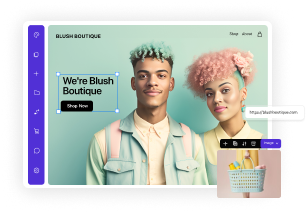Blog Vs Vlog: What’s The Difference?
Updated Feb 25, 2025 | Published Oct 31, 2024 | 12 min read

Content creators have a wealth of options when it comes to choosing the format for sharing their ideas and monetizing their media output.
Blogging and vlogging are two of the most popular types of content creation, capable of reaching millions of people and transforming a hobby into a full-time job.
This guide explores the differences between a blog vs vlog to help you decide which approach best suits your subject matter and skill set.
With more people choosing to earn money through online content creation, blogging and vlogging have increased in popularity thanks to easy-to-use tools and promotional methods.
Both have unique advantages and disadvantages, depending on your particular skills and experience and the type of content you want to produce.
Several monetization options for blog content and videos make them ideal for those looking for a side hustle to pay off debt.
Let’s explore the key differences and advantages between a blog and a vlog so you can choose the format that delivers the best audience engagement while making money online.
The word “blog” is shorthand for weblog, which refers to the original online journals people shared with readers on various blogging platforms.
There are millions of blogs worldwide covering a broad spectrum of subjects, from blogs about hobbies and interests to blogs covering professional industry information.
A blog post is presented primarily as written content similar to a new article, with additional media such as infographics and images also often included.
Often published on self-hosted blog platforms, bloggers can share written content with their audience on various social media platforms.
With no barrier to entry, blogging as a side hustle is a great way to connect with like-minded people and share insights into topics that forge a personal connection with the audience.
Start blogging with Friday’s website builder.
While a blog primarily focuses on written content, vlog content revolves around the video format, whether sharing personal stories or information about a specific subject.
Like blogging, vlogging is on the rise, with vloggers worldwide creating content for YouTube, TikTok, Twitch, and other video-sharing platforms.
YouTube alone has two billion users and millions of videos posted annually across all categories, from online courses and mom YouTube channels to video game livestreams.
Writing skills that apply to blogging are also necessary for vlogging, as is access to video editing software, cameras, and microphones.
This makes vlogging less accessible than blogging, although it is possible to begin vlogging using a smartphone and free editing software.
Some creators will incorporate elements of blogging and vlogging into their content creation to maximize their online reach and potential revenue opportunities.
We’ve covered the basic definitions of a blog and vlog and how each format can generate income by sharing content with like-minded people.
Now, let’s explore the key differences between a blog and a vlog in more detail so you can assess which approach works best for your budget and abilities.
As we’ve touched on, the most apparent difference between blogging and vlogging is the general format, with blogs focused on written content and vlogs concentrating on video content.
With blogging, content creators need to have the ability to articulate ideas and concepts clearly and concisely, using the correct spelling and grammar.
Formatting text correctly, such as using bullet lists, headers, and tables, is also important to ensure the content is easy to read.
Likewise, blog content often includes relevant images and other visual information that supports the text and further enhances the readability.
By contrast, vlog content, whether from a mom influencer on Instagram or an educational YouTube channel, is based on posting high-quality videos.
The subject may be the same as a blog, but it is presented through video imagery and often accompanied by the creator delivering narration or other dialogue.
This makes a video blog a better option for those who want to fully express their personality, talk directly to the audience, or collaborate with other content creators.
Sign up for Friday and create a blog.
Whether setting up a mom blog or breaking into lifestyle and travel blogging, you’ll need the right software and resources to get up and running.
Fortunately, blogging requires minimal overheads and investment, and there are many free and affordable blogging platforms to choose from.
You’ll need a blogging platform that includes a content management system for your other assets, and most bloggers typically integrate this into their own website.
On the other hand, setting up a vlog, which stands for video log, requires additional equipment, notably a video camera and more in-depth editing software.
There are free video editing software options, including Shotcut and iMovie, and paid options for professional editing, such as DaVinci Resolve and Adobe Premiere Pro.
Some vloggers use their smartphone instead of a video camera, while others have high-end setups, including professional studio lighting rigs and multi-camera installations.
Recommended: Find out how much it costs to build a website.
The learning curves for blogging and vlogging are also very different, although your previous experience, writing skills, and video editing will impact this progression.
For blogging, you’ll need to understand the writing process and create content that reads clearly and includes appropriate optimization for search engines.
You’ll also need to learn how to use your blog website builder’s content management system for other assets, such as images.
Other skills, such as a basic understanding of graphic design, can be helpful when blogging, such as designing a logo for your blog website.
Vloggers must master various skills, from developing a compelling on-screen presence to writing scripts, learning videography, and editing videos.
As such, many creators will draw on additional talent to help with the process, such as hiring someone with YouTube video editing skills to finalize the content.
This gives vlogging a steeper learning curve and more processes to master than blogging, with many content creators refining their approach over time.
Tip: Find out everything you need to know to make a website.
Search engine optimization is essential to ensure your blog or vlog reaches the broadest possible audience on platforms like Google and Bing.
For blogs, this is accomplished by using keywords in the text that relate to the terms people search for when looking for content.
Various tools can be used to determine keywords, such as Google Keyword Planner and Google Analytics, which generate keywords based on your chosen parameters.
The best website builders also incorporate SEO tools into their platforms, with AI Assistant features that can auto-generate keywords for the user.
Likewise, website builders often include features for tracking SEO performance and optimizing content based on past results to increase their online reach.
Keywords also play a role in search engine optimization for vlogs, for instance, through video titles, tags, and descriptions.
Visual assets provide additional optimization for vloggers, with image thumbnails, preview images, and end screens all contributing to SEO.
SEO can be leveraged across multiple platforms for the best results, pairing keywords and other SEO-based assets on YouTube videos, blogs, and other content.
Blogs and vlogs both have great potential for monetization, whether through traditional advertising, sponsored content, or direct product sales to the audience.
There are several ways to monetize a blog and maximize the content format, provided you produce high-quality content and have a decent audience.
You can charge a subscription for exclusive blog content or ask for donations through platforms like Patreon to allow loyal followers to support your efforts.
Ads can be embedded into your website, or you can seek direct partnerships with brands selling products or services related to your chosen subject.
You can also set up an online store on your website to create and sell physical and digital products directly to your audience.
Advertising, sponsored content, and direct sales through an online store are monetization options for vloggers.
Running a vlog also allows for the development of an income stream through live chat donations, video ads, and memberships for exclusive content.
In short, the potential to make money blogging and vlogging is extensive, and there are no limitations on which methods you use to create content.
Set up an online store with Friday.
Now that we’ve broken down the key differences between a blog and a vlog let’s examine the advantages each format offers content creators.
Here are the core advantages of blogging:
Before taking the plunge into writing content, take the time to fully understand the pros and cons of blogging to make sure it’s the best choice for you.
Create a stunning website with Friday’s templates.
Vlog content also has several advantages that make it a compelling format for content creators looking to build a loyal audience.
Here are some advantages to vlogging:
If you’re considering creating this type of content, you can reference many successful vlogs online to help you develop an engaging style that draws in the audience.
If you’re considering creating a blog but are unsure how to go about it, there are several crucial steps you can follow to deliver the best results.
Here’s a brief overview of the process you need to follow:
These steps apply to all blog types, whether setting up a fitness blog for moms or blogging about the latest trends in technology or finance.
Read more: Check out this essential blog post checklist.
Beginning your journey as a vlogger is more complicated than setting up a blog, but there are some key steps you can take to get things right:
To set up a vlog, follow these instructions:
There are many excellent tools for freelancers to streamline their workflows, such as managing their schedules, editing videos, and sharing content on social media platforms.
Explore Friday’s competitive pricing.
Blogging and vlogging continue to rise in popularity among content creators looking to earn extra money on the side or share their passion for a hobby.
Whether you’re interested in creating YouTube videos or making money blogging, this guide’s information will help you launch your venture on the right foot.
You can incorporate elements of blogs and video content into your overall content creation strategy, tailoring it to your intended target audience.
